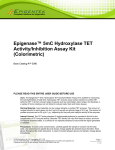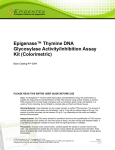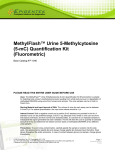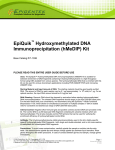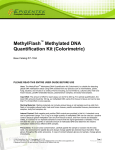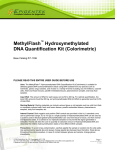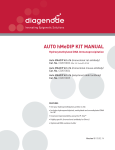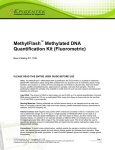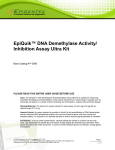Download 5-fC - Epigentek
Transcript
EPIGENTEK Complete Solutions for Epigenetics MethylFlash™ 5-Formylcytosine (5-fC) DNA Quantification Kit (Colorimetric) Base Catalog # P-1041 PLEASE READ THIS ENTIRE USER GUIDE BEFORE USE Uses: The MethylFlash™ 5-Formylcytosine (5-fC) DNA Quantification Kit (Colorimetric) is a complete set of optimized buffers and reagents to colorimetrically quantify 5-formylcytosine (5-fC) in a microplate-based format. It is suitable for use with DNA isolated from any species (mammals, plants, fungi, bacteria, viruses, etc.) in a variety of forms including, but not limited to, cultured cells, fresh and frozen tissues, paraffinembedded tissues, and body fluid samples. Input DNA: The amount of DNA for each assay can be 100 ng to 300 ng. For optimal quantification the input DNA amount should be 300 ng, as 5-fC content is generally less than 0.01% of total DNA. Starting Material: Starting materials can include various tissue or cell samples, for example, cells from flask or microplate cultured cells, fresh and frozen tissues, paraffin-embedded tissues, blood, body fluid samples, etc. Internal Control: Both negative and positive DNA controls are provided in this kit. A standard curve can be performed (range: 10 pg to 400 pg of 5-fC) or a single quantity of 5-fC can be used as a positive control. Because 5-fC content can vary from tissue to tissue, and from normal and diseased states, or vary under treated and untreated conditions, it is advised to run replicate samples to ensure that the signal generated is validated. This kit will allow the user to quantify an absolute amount of 5-fC and determine the relative 5-fC states of two different DNA samples. Precautions: To avoid cross-contamination, carefully pipette the sample or solution into the strip-wells. Use aerosol-barrier pipette tips and always change pipette tips between liquid transfers. Wear gloves throughout the entire procedure. In case of contact between gloves and sample, change gloves immediately. 110 Bi County Blvd. Ste. 122, Farmingdale, NY 11735 Tel: 1-877-374-4368 ■ Fax: 1-718-484-3956 ■ E-mail: [email protected] ■ Web: www.epigentek.com © Epigentek Group Inc. All rights reserved. Products are for research use only. Page 1 Printed 2015-08-20 P-1041 EPIGENTEK Complete Solutions for Epigenetics KIT CONTENTS Component 48 Assays Cat. #P-1041-48 96 Assays Cat. #P-1041-96 Storage Upon Receipt WB (10X Wash Buffer) 14 ml 28 ml 4°C BS (Binding Solution) 5 ml 10 ml RT NC (Negative Control, 10 µg/ml)* 10 µl 20 µl –20°C PC (Positive Control, 5-fC 1 µg/ml)* 10 µl 20 µl –20°C CA (Capture Antibody, 1000X) * 4 µl 8 µl 4°C DA (Detection Antibody, 2000X)* 6 µl 12 µl –20°C ES (Enhancer Solution)* 5 µl 10 µl –20°C DS (Developer Solution) 5 ml 10 ml 4°C SS (Stop Solution) 5 ml 10 ml RT 8-Well Assay Strips (With Frame) 6 12 4°C User Guide 1 1 RT * Spin the solution down to the bottom prior to use. Note: The NC Negative Control is an oligo containing no 5-fC. The PC Positive Control is a 5-fC oligo and is normalized to have 100% of 5-fC. SHIPPING & STORAGE The kit is shipped in two parts: the first part at ambient room temperature and the second part on frozen ice packs at 4°C. Upon receipt: (1) Store NC, PC, DA, and ES at –20°C away from light; (2) Store WB, CA, DS, and 8-Well Assay Strips at 4°C away from light; (3) Store remaining components (BS and SS) at room temperature away from light. Note: Check if the wash buffer, WB, contains salt precipitates before using. If so, warm (at room temperature or 37°C) and shake the buffer until the salts are re-dissolved. All components of the kit are stable for 6 months from the date of shipment, when stored properly. MATERIALS REQUIRED BUT NOT SUPPLIED Adjustable pipette Aerosol resistant pipette tips Microplate reader capable of reading absorbance at 450 nm 1.5 ml microcentrifuge tubes Incubator for 37°C incubation Plate seal or Parafilm M 110 Bi County Blvd. Ste. 122, Farmingdale, NY 11735 Tel: 1-877-374-4368 ■ Fax: 1-718-484-3956 ■ E-mail: [email protected] ■ Web: www.epigentek.com © Epigentek Group Inc. All rights reserved. Products are for research use only. Page 2 Printed 2015-08-20 P-1041 EPIGENTEK Complete Solutions for Epigenetics Distilled water 1X TE buffer pH 7.5 to 8.0 Isolated DNA of interest GENERAL PRODUCT INFORMATION Quality Control: Each lot of the MethylFlash™ 5-Formylcytosine (5-fC) DNA Quantification Kit (Colorimetric) is tested against predetermined specifications to ensure consistent product quality. Epigentek guarantees the performance of all products in the manner described in our product instructions. Product Warranty: If this product does not meet your expectations, simply contact our technical support unit or your regional distributor. We also encourage you to contact us if you have any suggestions about product performance or new applications and techniques. Safety: Suitable lab coat, disposable gloves, and proper eye protection are required when working with this product. Product Updates: Epigentek reserves the right to change or modify any product to enhance its performance and design. The information in this User Guide is subject to change at any time without notice. Thus, only use the User Guide that was supplied with the kit when using that kit. Usage Limitation: The MethylFlash™ 5-Formylcytosine (5-fC) DNA Quantification Kit (Colorimetric) is for research use only and is not intended for diagnostic or therapeutic application. Intellectual Property: The MethylFlash™ 5-Formylcytosine (5-fC) DNA Quantification Kit (Colorimetric) and methods of use contain proprietary technologies by Epigentek. A BRIEF OVERVIEW DNA methylation occurs by the covalent addition of a methyl group at the 5-carbon of the cytosine ring by DNA methyltransferases, resulting in 5-methylcytosine (5mC). In somatic cells, 5mC is found almost exclusively in the context of paired symmetrical methylation of the dinucleotide CpG, whereas in embryonic stem (ES) cells, a substantial amount of 5mC is also observed in non-CpG contexts. The biological importance of 5mC as a major epigenetic modifier of phenotype and gene expression has been recognized widely. 5-hydroxymethylcytosine (5hmC), as a sixth DNA base with functions in transcription regulation, has been detected to be abundant in the human brain, the mouse brain, and in embryonic stem (ES) cells. In mammals, it can be generated by the oxidation of 5mC, a reaction mediated by the ten-eleven translocation (TET) family of 5mC-hydroxylases. 5hmC can be further oxidized to 5-formylcytosine (5-fC) and 5carboxylcytosine (5-caC) through TET hydroxylases. 5-formylcytosine (5-fC) has recently been found in mammalian tissue and cells and has been classified as a seventh DNA base. The function of 5-fC in gene regulation is not yet entirely clear, but it has been shown that 5-fC exhibits replication-dependent dilution during mouse pre-implantation development and could be functional in regulating pre-implantation development as a whole. The detection of 5-fC in various tissues and cells is important because 5-fC could be a marker to indicate active DNA demethylation. 5-fC can also be directly excised by Thymine DNA glycosylase (TDG) to allow subsequent base excision repair (BER) processing, which converts modified cytosine back to its unmodified state. 110 Bi County Blvd. Ste. 122, Farmingdale, NY 11735 Tel: 1-877-374-4368 ■ Fax: 1-718-484-3956 ■ E-mail: [email protected] ■ Web: www.epigentek.com © Epigentek Group Inc. All rights reserved. Products are for research use only. Page 3 Printed 2015-08-20 P-1041 EPIGENTEK Complete Solutions for Epigenetics Active demethylation of 5-methylcytosine by TET-mediated oxidation to 5-hydroxymethylcytosine, 5-formylcytosine and 5carboxylcytosine, followed by decarboxylation/base excision repair. Wu et al: Nat. Rev. Mol. Cell Biol. 11, 607-620, 2010. Several chromatography-based techniques such as HPLC-MS are used for the detection of 5-fC in tissue and cells. However, these methods are time consuming, require large amounts of DNA and have low throughput with high costs. To address these problems, Epigentek offers the MethylFlash™ 5Formylcytosine (5-fC) DNA Quantification Kit (Colorimetric), which uses a unique microplate-based procedure to directly quantify 5-fC. The kit has the following advantages and features: Colorimetric assay with easy-to-follow steps for convenience and speed. The entire procedure can be completed within 3 hours and 45 minutes. High sensitivity, of which the detection limit can be as low as 1 pg of 5-fC. High specificity with detection of only 5-fC. No cross-reactivity to cytosine, 5-mC, 5-hmC and 5-caC within the indicated concentration range of the sample DNA. Highly convenient assay with direct use of DNA isolated from cells or tissues, no need for DNA digestion or hydrolysis. Universal positive and negative controls are included, which are suitable for quantifying 5-fC from any species. Strip-well microplate format makes the assay flexible: manual or high throughput analysis. Simple, reliable, and consistent assay conditions PRINCIPLE & PROCEDURE The MethylFlash™ 5-Formylcytosine (5-fC) DNA Quantification Kit (Colorimetric) contains all the reagents necessary for the quantification of 5-fC. In this assay, DNA is bound to strip-wells that are specifically treated to have a high DNA affinity. 5-fC is detected using capture and detection antibodies. The detected signal is enhanced and then quantified colorimetrically by reading the absorbance in a microplate spectrophotometer. The amount of 5-fC is proportional to the OD intensity measured. 110 Bi County Blvd. Ste. 122, Farmingdale, NY 11735 Tel: 1-877-374-4368 ■ Fax: 1-718-484-3956 ■ E-mail: [email protected] ■ Web: www.epigentek.com © Epigentek Group Inc. All rights reserved. Products are for research use only. Page 4 Printed 2015-08-20 P-1041 EPIGENTEK Complete Solutions for Epigenetics Schematic procedure of the MethylFlash™ 5-Formylcytosine (5-fC) DNA Quantification Kit (Colorimetric) 0.6 OD450 nm 0.5 0.4 0.3 0.2 0.1 0 0 0.1 0.2 0.3 0.4 5-fC (ng) 5-fC standard control was added into the assay wells at different concentrations and then measured with the MethylFlash™ 5-Formylcytosine (5-fC) DNA Quantification Kit (Colorimetric) 110 Bi County Blvd. Ste. 122, Farmingdale, NY 11735 Tel: 1-877-374-4368 ■ Fax: 1-718-484-3956 ■ E-mail: [email protected] ■ Web: www.epigentek.com © Epigentek Group Inc. All rights reserved. Products are for research use only. Page 5 Printed 2015-08-20 P-1041 EPIGENTEK Complete Solutions for Epigenetics ASSAY PROTOCOL For the best results, please read the protocol in its entirety prior to starting your experiment. Starting Materials Input DNA Amount: DNA amount can range from 100 ng to 300 ng per reaction. An optimal amount is 300 ng per reaction. Starting DNA may be in water or in a buffer such as TE. DNA Isolation: You can use your method of choice for DNA isolation. Epigentek offers a series of genomic DNA isolation kits for your convenience (See “Ordering Information”). DNA Storage: Isolated genomic DNA can be stored at 4°C (short term) or –20°C (long term) until use. 1. Buffer and Solution Preparation a. Prepare Diluted WB 1X Wash Buffer: 48-Assay Kit: Add 13 ml of WB 10X Wash Buffer to 117 ml of distilled water (final pH 7.2-7.5). 96-Assay Kit: Add 26 ml of WB 10X Wash Buffer to 234 ml of distilled water (final pH 7.2-7.5). This Diluted WB 1X Wash Buffer can now be stored at 4°C for up to six months. b. Prepare Diluted CA Capture Antibody Solution: Dilute CA (Capture Antibody) with Diluted WB at a ratio of 1:1000 (i.e., add 1 µl of CA to 1000 µl of Diluted WB). About 50 µl of this Diluted CA solution will be required for each assay well. c. Prepare Diluted DA Detection Antibody Solution: Dilute DA (Detection Antibody) with Diluted WB at a ratio of 1:2000 (i.e., add 1 µl of DA to 2000 µl of Diluted WB). About 50 µl of this Diluted DA solution will be required for each assay well. d. Prepare Diluted ES Enhancer Solution: Dilute ES Enhancer Solution with Diluted WB at a ratio of 1:5000 (i.e., add 1 µl of ES to 5000 µl of Diluted WB). About 50 µl of this Diluted ES solution will be required for each assay well. e. Prepare Diluted PC Positive Control: Single Point Control Prep: Dilute PC Positive Control with 1X TE to 200 pg/µl (2 µl PC + 8 µl TE). Suggested Standard Curve Prep: First, dilute PC to 400 pg/µl (4 µl of PC + 6 µl of 1X TE). Then, further prepare 6 different concentrations with the 400 pg/µl diluted PC and 1X TE into 10, 20, 40, 100, 200, and 400 pg/µl according to the following dilution chart: 110 Bi County Blvd. Ste. 122, Farmingdale, NY 11735 Tel: 1-877-374-4368 ■ Fax: 1-718-484-3956 ■ E-mail: [email protected] ■ Web: www.epigentek.com © Epigentek Group Inc. All rights reserved. Products are for research use only. Page 6 Printed 2015-08-20 P-1041 EPIGENTEK Complete Solutions for Epigenetics Tube PC (400 pg/µl) 1X TE Resulting PC Concentration 1 1.0 µl 39.0 µl 10 pg/µl 2 1.0 µl 19.0 µl 20 pg/µl 3 1.0 µl 9.0 µl 40 pg/µl 4 1.0 µl 3.0 µl 100 pg/µl 5 2.0 µl 2.0 µl 200 pg/µl 6 3.0 µl 0.0 µl 400 pg/µl Note: Keep each of the diluted solutions (except Diluted WB 1X Wash Buffer) on ice until use. Any remaining diluted solutions, other than Diluted WB, should be discarded if not used within the same day. 2. DNA Binding a. Predetermine the number of strip-wells required for your experiment. Carefully remove un-needed strip-wells from the plate frame and place them back in the bag (seal the bag tightly and store at 4°C). b. Add 80 µl of BS Binding Solution to each well. c. Add 1 µl of NC, 1 µl of Diluted PC (see note below), and 300 ng of your Sample DNA (1-8 µl) into the designated wells depicted in Table 1 or Table 2. Mix solution by gently tilting from side to side or shaking the plate several times. Ensure the solution coats the bottom of the well evenly. Note: (1) For a single point control, add 1 µl of PC at a concentration of 200 pg/µl as prepared in Step 1e; For the standard curve, add 1 µl of Diluted PC at concentrations of 10 to 400 pg/µl (see the chart in Step 2). The final amounts should be 10, 20, 40, 100, 200 and 400 pg per well. (2) For optimal binding, sample DNA volume added should not exceed 8 µl. (3) To ensure that the NC, Diluted PC, and sample DNA are completely added into the wells, the pipette tip should be placed in the BS Bind Solution in the well and aspirated in/out 1-2 times. d. Cover strip plate with plate seal or Parafilm M and incubate at 37°C for 90 min. e. Remove the BS Binding Solution from each well. Wash each well with 150 µl of the Diluted WB 1X Wash Buffer each time for three times. This can be done by simply pipetting Diluted WB in and out of the wells. 3. 5-fC DNA Capture a. Add 50 µl of the Diluted CA to each well, then cover and incubate at room temperature for 60 min. b. Remove the Diluted CA solution from each well. c. Wash each well with 150 µl of the Diluted WB each time for three times. d. Add 50 µl of the Diluted DA to each well, then cover and incubate at room temperature for 30 min. e. Remove the Diluted DA solution from each well. f. Wash each well with 150 µl of the Diluted WB each time for four times. g. Add 50 µl of the Diluted ES to each well, then cover and incubate at room temperature for 30 min. 110 Bi County Blvd. Ste. 122, Farmingdale, NY 11735 Tel: 1-877-374-4368 ■ Fax: 1-718-484-3956 ■ E-mail: [email protected] ■ Web: www.epigentek.com © Epigentek Group Inc. All rights reserved. Products are for research use only. Page 7 Printed 2015-08-20 P-1041 EPIGENTEK Complete Solutions for Epigenetics h. Remove the Diluted ES solution from each well. i. Wash each well with 150 µl of the Diluted WB each time for five times. 4. Signal Detection a. Add 100 µl of DS to each well and incubate at room temperature for 1 to 10 min away from light. Begin monitoring color change in the sample wells and control wells. The DS solution will turn blue in the presence of sufficient 5-fC. b. Add 100 µl of SS to each well to stop enzyme reaction when color in the positive control wells turns medium blue. Mix the solution by gently shaking the frame and wait 1-2 min to allow the color reaction to completely stop. The color will change to yellow after adding SS and the absorbance should be read on a microplate reader at 450 nm within 2 to 15 min. Note: If the strip-well plate frame does not fit in the microplate reader, transfer the solution to a standard 96well microplate. 5. 5-fC Calculation Relative Quantification: To determine the relative 5-fC status of two different DNA samples, simple calculation for the percentage of 5-fC in your total DNA can be carried out using the following formula: (Sample OD – NC OD) ÷ S x 100% 5-fC % = (PC OD – NC OD) ÷ P S is the amount of input sample DNA in ng. P is the amount of input positive control (PC) in ng. Example calculation: Average OD450 of Average OD450 of Average OD450 of S is 300 ng P is 0.2 ng (200 5-fC % = NC is 0.120 PC is 0.320 Sample is 0.141 pg) (0.141 – 0.120) ÷ 300 (0.320 – 0.120)÷ 0.2 x 100% = 0.007% Absolute Quantification: To quantify the absolute amount of 5-fC using an accurate calculation, first generate a standard curve and plot the OD values versus the amount of PC at each concentration point. Next, determine the slope (OD/ng) of the standard curve using linear regression (Microsoft Excel’s linear regression functions are suitable for such calculation) and the most linear part (at least 4 concentration points including 0 point) of the standard curve for optimal slope calculation. Now calculate the amount and percentage of 5-fC in your total DNA using the following formulas: Sample OD – NC OD 5-fC (ng) = Slope 5-fC Amount (ng) 5-fC % = x 100% S S is the amount of input sample DNA in ng. 110 Bi County Blvd. Ste. 122, Farmingdale, NY 11735 Tel: 1-877-374-4368 ■ Fax: 1-718-484-3956 ■ E-mail: [email protected] ■ Web: www.epigentek.com © Epigentek Group Inc. All rights reserved. Products are for research use only. Page 8 Printed 2015-08-20 P-1041 EPIGENTEK Complete Solutions for Epigenetics Example calculation: Average OD450 of NC is 0.120 Average OD450 of sample is 0.141 Slope is 1 OD/ng S is 300 ng 0.141 – 0.120 5-fC (ng) = = 0.021 ng 1 0.021 5-fC % = 300 x 100% = 0.007% SUGGESTED STRIP-WELL SETUP Table 1. Single Point Positive Control. The suggested strip-well plate setup using a single point positive control in a 48assay format (in a 96-assay format, Strips 7 to 12 can be configured as Sample). The controls and samples can be measured in duplicate. Well # A B C D E F G H Strip 1 Strip 2 Strip 3 Strip 4 Strip 5 Strip 6 NC PC Sample Sample Sample Sample Sample Sample NC PC Sample Sample Sample Sample Sample Sample Sample Sample Sample Sample Sample Sample Sample Sample Sample Sample Sample Sample Sample Sample Sample Sample Sample Sample Sample Sample Sample Sample Sample Sample Sample Sample Sample Sample Sample Sample Sample Sample Table 2. Standard Curve Preparation. The suggested strip-well plate setup for standard curve preparation in a 48assay format (in a 96-assay format, Strips 7 to 12 can be configured as Sample). The controls and samples can be measured in duplicate. Well # A B C D E F G H Strip 1 Strip 2 Strip 3 Strip 4 Strip 5 Strip 6 NC PC 10 pg/µl PC 20 pg/µl PC 40 pg/µl PC 100 pg/µl PC 200 pg/µl PC 400 pg/µl Sample NC PC 10 pg/µl PC 20 pg/µl PC 40 pg/µl PC 100 pg/µl PC 200 pg/µl PC 400 pg/µl Sample Sample Sample Sample Sample Sample Sample Sample Sample Sample Sample Sample Sample Sample Sample Sample Sample Sample Sample Sample Sample Sample Sample Sample Sample Sample Sample Sample Sample Sample Sample Sample Sample Suggested Working Buffer and Solution Setup Table 3. Approximate amount of required buffers and solutions for defined assay wells based on the protocol. 110 Bi County Blvd. Ste. 122, Farmingdale, NY 11735 Tel: 1-877-374-4368 ■ Fax: 1-718-484-3956 ■ E-mail: [email protected] ■ Web: www.epigentek.com © Epigentek Group Inc. All rights reserved. Products are for research use only. Page 9 Printed 2015-08-20 P-1041 EPIGENTEK Complete Solutions for Epigenetics Reagents 1 well 8 wells (1 strip) 16 wells (2 strips) 48 wells (6 strips) 96 wells (12 strips) Diluted WB 2.5 ml 20 ml 40 ml 120 ml 240 ml BS 80 µl 640 µl 1300 µl 3900 µl 8000 µl Diluted CA 50 µl 400 µl 800 µl 2400 µl 4800 µl Diluted DA 50 µl 400 µl 800 µl 2400 µl 4800 µl Diluted ES 50 µl 400 µl 800 µl 2400 µl 4800 µl DS 0.1 ml 0.8 ml 1.6 ml 4.8 ml 9.6 ml SS 0.1 ml 0.8 ml 1.6 ml 4.8 ml 9.6 ml NC N/A 0.5 µl – 1 µl 0.5 µl – 2 µl 1 µl – 4 µl 2 µl – 8 µl PC N/A 0.5 µl – 1 µl 0.5 µl – 2 µl 1 µl – 4 µl 2 µl – 8 µl TROUBLESHOOTING Problem Possible Cause Suggestion No signal in both the positive control and sample wells Reagents are added incorrectly. Check if reagents are added in the proper order and if any steps in the protocol may have been omitted by mistake. The well is incorrectly washed before DNA binding. Ensure the well is not washed prior to adding the positive control and sample. The bottom of the well is not completely covered by the BS Binding Solution. Ensure the solution coats the bottom of the well by gently tilting from side to side or shaking the plate several times. Incubation time and temperature are incorrect. Ensure the incubation time and temperature described in the protocol are followed correctly. Insufficient input materials. Ensure that a sufficient amount of positive control (> 50 pg) and samples (300 ng) is added into the wells. Incorrect absorbance reading. Check if appropriate absorbance wavelength (450 nm) is used. Kit was not stored or handled properly. Ensure all components of the kit were stored at the appropriate temperature and the cap is tightly capped after each opening or use. The positive control is insufficiently added to the well in Step 2c. Ensure a sufficient amount of positive control DNA is added. The PC Positive Control is degraded due to improper storage conditions. Follow the Shipping & Storage guidance of this User Guide for storage of PC Positive Control. No signal or weak signal in only the positive control wells 110 Bi County Blvd. Ste. 122, Farmingdale, NY 11735 Tel: 1-877-374-4368 ■ Fax: 1-718-484-3956 ■ E-mail: [email protected] ■ Web: www.epigentek.com © Epigentek Group Inc. All rights reserved. Products are for research use only. Page 10 Printed 2015-08-20 P-1041 EPIGENTEK Complete Solutions for Epigenetics High background present in the negative control wells No signal or weak signal only in sample wells Uneven color development Large variation between replicate wells Insufficient washing of wells. Check if washing recommendations at each step are performed according to the protocol. Contaminated by sample or positive control. Ensure the well is not contaminated from accidentally adding sample or positive control DNA or from using contaminated tips. Incubation time is too long. The incubation time at Step 2d should not exceed 2 h. Over development of color. Decrease the development time in Step 4a before adding SS Stop Solution in Step 4b. DNA sample is not properly extracted or purified Ensure the DNA sample is in good quality 260/280 ratio should be >1.7 with no or minimal RNA contamination. Sample amount added into the wells is insufficient. Ensure a sufficient amount of DNA is used as indicated in Step 2. Little or no 5-fC contained in the sample. N/A Insufficient washing of the wells. Ensure the wells are washed according to the guidance of washing and residue washing buffer is removed as much as possible. Delayed color development or delayed stopping of color development in the wells. Ensure color development solution or stop solution is added sequentially and is consistent with the order in which you added the other reagents (e.g., from well A to well G or from well 1 to well 12). Color reaction is not evenly stopped due to an inconsistency in pipetting time. Ensure DS Developer Solution and SS Stop Solution are added at the same time between replicates or otherwise maintain a consistent timing in between each addition of solutions. Color reaction is not evenly stopped due to an inconsistent order of adding solutions. Ensure all solutions, particularly DS Developer Solution and SS Stop Solution, are added in the same order each time as all other solutions. The solutions are not evenly added due to inconsistency in pipetting volume. Ensure the solution in each pipette tip is equal in the multi-channel pipette. Equilibrate the pipette tip in any solutions before adding them. Ensure the solutions, especially those with small volumes (e.g., 1 ul) are completely added into the wells. Solutions or antibodies were not actually added into the wells. Do not allow pipette tip to touch the outer edges or inner sides of the wells to prevent solutions from sticking to the surface. 110 Bi County Blvd. Ste. 122, Farmingdale, NY 11735 Tel: 1-877-374-4368 ■ Fax: 1-718-484-3956 ■ E-mail: [email protected] ■ Web: www.epigentek.com © Epigentek Group Inc. All rights reserved. Products are for research use only. Page 11 Printed 2015-08-20 P-1041 EPIGENTEK Complete Solutions for Epigenetics Capture Antibody vial appears to be empty or insufficient in volume Did not sufficiently shake the solutions in the wells after adding SS Stop Solution at Step 4b Gently and evenly shake the plate frame across a flat surface so that the solutions in the wells are better distributed. Do not stir. Did not use the same pipette device throughout the experiment. Use the same multi-channel pipette device throughout the entire experiment, as different pipette devices may have slight variations in performance. Buffer evaporated due to the very small volumes, resulting in a higher concentrated antibody. Add 1X PBS buffer into the Capture Antibody vial until you restore the correct, intended volume according to the Kit Contents described in this User Guide. Mix and centrifuge prior to use. RELATED PRODUCTS DNA Sample Preparation P-1003 FitAmp™ General Tissue Section DNA Isolation Kit P-1004 FitAmp™ Plasma/Serum DNA Isolation Kit P-1006 DNA Concentrator Kit P-1007 FitAmp™ Gel DNA Isolation Kit P-1009 FitAmp™ Paraffin Tissue Section DNA Isolation Kit P-1017 FitAmp™ Urine DNA Isolation Kit P-1018 FitAmp™ Blood and Cultured Cell DNA Extraction Kit Methylated and Hydroxymethylated DNA Quantification P-1034 MethylFlash™ Methylated DNA Quantification Kit (Colorimetric) P-1035 MethylFlash™ Methylated DNA Quantification Kit (Fluorometric) P-1036 MethylFlash™ Hydroxymethylated DNA Quantification Kit (Colorimetric) P-1037 MethylFlash™ Hydroxymethylated DNA Quantification Kit (Fluorometric) Hydroxymethylated DNA Immunoprecipitation P-1038 MethylFlash™ Hydroxymethylated DNA Immunoprecipitation (hmeDIP) Kit DNA Demethylation Enzyme Activity Assay P-3019 P-3086 P-3087 EpiQuik™ DNA Demethylase Activity/Inhibition Assay Kit Epigenase™ 5mC Hydroxylase TET Activity/Inhibition Assay Kit (Colorimetric) Epigenase™ 5mC Hydroxylase TET Activity/Inhibition Assay Kit (Fluorometric) 110 Bi County Blvd. Ste. 122, Farmingdale, NY 11735 Tel: 1-877-374-4368 ■ Fax: 1-718-484-3956 ■ E-mail: [email protected] ■ Web: www.epigentek.com © Epigentek Group Inc. All rights reserved. Products are for research use only. Page 12 Printed 2015-08-20 P-1041












